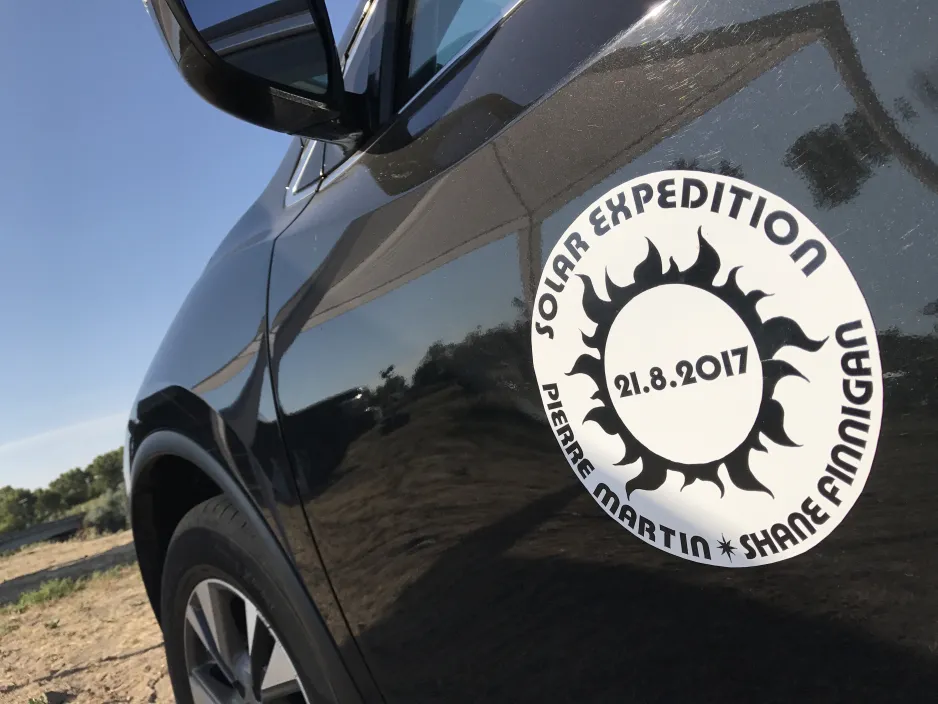A dream come true: My solar eclipse expedition


I have been deeply fascinated by astronomy and space exploration for over 33 years (since I was nine years old). I can remember at a young age staring at the sky at night, and then sifting through astronomy books with a thirst to learn as much as I could. Over the years, my interest continued with a fondness for transient astronomical phenomena such as meteor showers, planets, eclipses, and aurora borealis. I will often drive long distances to be in a good position to view these events.
I've always dreamed of experiencing a Total Solar Eclipse, the rare occurrence when the Moon completely covers the Sun — and daylight turns into a deep twilight, dark enough for stars and planets to be easily visible in the sky! The wispy aura of plasma surrounding the Sun, known as the corona, is often described as one of the most spectacular sights that nature can offer. In any given place on Earth, a total eclipse appears just once every 375 years.
On August 21, 2017, for the first time since 1918, a total solar eclipse would march across the entire United States, from Oregon to South Carolina. Although most of North America would see a partial eclipse, totality is far more elusive. It's only visible for a very short time, to those lucky enough to be within about a 100 km wide path.

A commemorative decal designed in honour of the expedition.
A road trip adventure
I decided that this eclipse was an opportunity to make my dream come true. A friend and I embarked on a 3,600 km road trip adventure to Idaho! This long journey was necessary to escape potentially poor weather conditions in the east, as well as very crowded areas. Along the way, we explored a number of museums and other attractions. In Idaho, we met with another good friend from Ottawa who was at his cousin's brother-in-law. This private property happened to be perfectly well positioned within the centre line of totality — and we were graciously invited to join them!
On the day before the eclipse, we all went to work setting up a plethora of cameras and telescopes, specially equipped for viewing and imaging the Sun safely. We practiced our routines over and over to minimize the chance of having things go wrong. We knew we had only one shot at this. With a mere two minutes of totality, our cameras, batteries and other accessories had to be working perfectly.

Pierre Martin's equipment, set up and ready for the solar eclipse.
Before we knew it, it was eclipse day. I woke up at sunrise with a clear blue sky — not a cloud in sight. It was time for the final preparations! My equipment consisted of a camera with a wide-angle lens on a tripod, which would take an exposure every five minutes to capture the long-lasting partial phases, along with the short bit of totality. For a close-up view, I had a second camera with a telephoto lens, set up on an equatorial mount that provided tracking to keep the Sun centred. This camera was connected to a computer with the Solar Eclipse Maestro software to automate the photography. I prepared a custom script in the software that would trigger the camera to take pictures at very precise times, using specific settings in order to capture desired details at critical times. This set up also allowed me to be free to sit back and concentrate on observing the event visually.

A tiny “bite” off the right edge of the Sun marked the beginning of the eclipse.
A tiny “bite” off the right edge of the Sun marked the beginning of the eclipse. Anticipation and adrenalin were running high…and perhaps a touch of nervousness! Over the next hour, as the Moon slowly covered the Sun, the temperature started dropping. "Pin holes,” created by gaps between trees and other objects, projected a neat effect of crescent-shaped “Suns” on to the ground. It was about to finally happen — totality was imminent!

As the partial phase progresses, anticipation is building.
A surreal scene
During the last few moments before the Sun vanished, a number of things occurred rather quickly which all added up to a very surreal scene. The sky turned into a shade of deep blue and the quality of the light was unique — much like it would appear through polarized sunglasses. Birds flew erratically, seemingly confused by the changing light or perhaps they were returning to their nests. The temperature dropped sharply and shadows on the ground looked unnaturally sharp and well defined. Then, out in the western sky, a wide dark shape appeared and grew larger and larger. It was the Moon’s shadow zooming in towards us at about 3,600 km/h!

A brilliant “diamond ring” effect appears mere moments before totality.
At the start of totality, it felt like someone was “turning down the dimmer” on the sky. My camera began to click more rapidly, the tiniest glints of sunlight vanished, and the corona burst into view! I was immediately mesmerized by this glorious sight of nature. From a distant elevated plateau, the “whowwww!” from hundreds of people was heard all at once! The quality of the view into the binoculars — and even just with the eyes alone — was far beyond what I had imagined. Coronal streamers extended far past the Moon/Sun diameter, and the nearby bright star Regular was visible. This was unlike any eclipse photos that I had seen; human eyes have better overall dynamic range than cameras. Red erupting gases (prominences) were easy to see, appearing like tiny red spots around the disk.
Then, I stood up and looked around me to survey the scene without any instruments. A bright orange glow surrounded all of the horizons and gave the appearance of a 360-degree “twilight.” It looked like I was on another planet! Further up in the sky, I had no trouble spotting Venus, Jupiter, Sirius, and even the stars of the famous Orion constellation.

A wide-angle composite of the solar eclipse, consisting of digitally stacking one photo every five minutes of the entire eclipse.
A feeling like no other
Part of what makes a total eclipse so breathtaking has to do with invisible light. During the moment of totality, when the Sun is completely blocked, there is an exquisitely odd and wondrous sensation of solar emissions — both visible and invisible — vanishing right in the middle of the day. During those two minutes, I was indeed swept by emotions. This is not something that can be felt with a partial eclipse, even if it is as much as 99%. Only full totality produces the astonishing and absolutely remarkable phenomenon that resembles nothing else in our lives, on our planet, or in the known universe. We are fortunate that the apparent size of the Moon and the Sun are similar enough to create this unique phenomena — truly one of nature's grandest sights!

The end of totality generates a collective gasp from the crowd.
The two minutes of totality ended with a breathtaking "diamond ring" effect that signaled the return of sunlight. Our group cheered and celebrated, while a few dedicated people continued watching for another hour as the Moon gradually covered less and less of the Sun.
Better keep those “eclipse shades” handy! On April 8, 2024 another Total Solar Eclipse will pass through North America and will be visible to millions of people. Totality will start in Mexico, then move up into upstate New York, pass just south of Ottawa, Montreal and then go through the Maritimes. A much broader area of the continent will get to see a partial eclipse. This is an event that I recommend planning for well ahead of time, as it will likely attract millions of visitors from all around the world. They will all have one major goal — to stand in the Moon's tiny shadow and witness a grand spectacle.






















